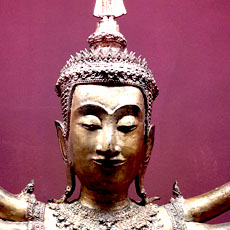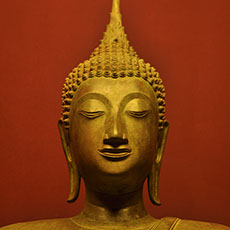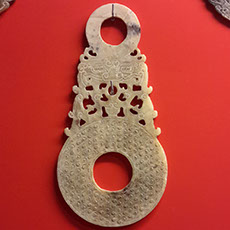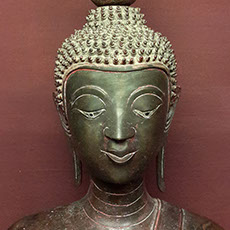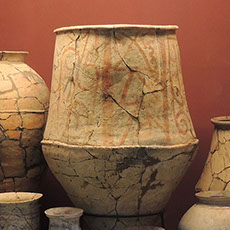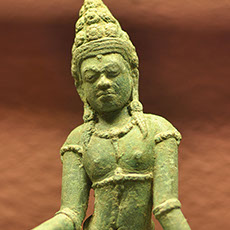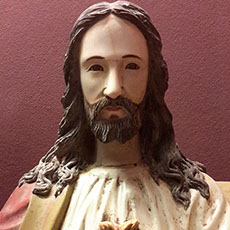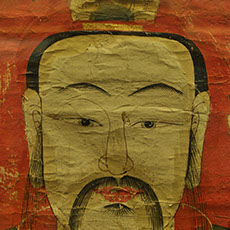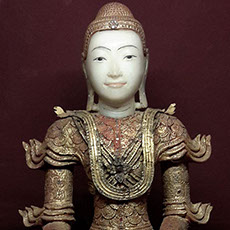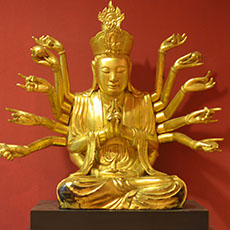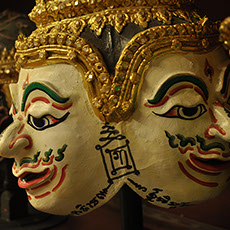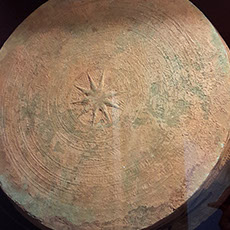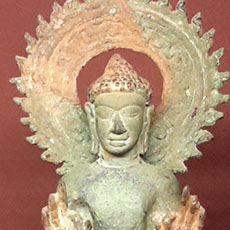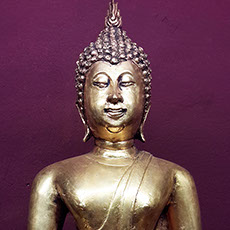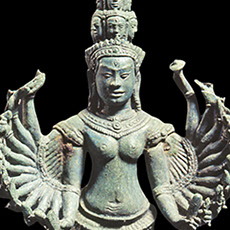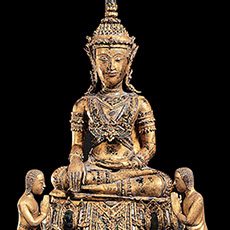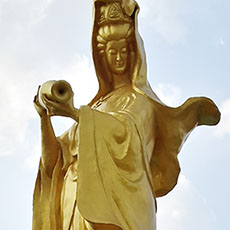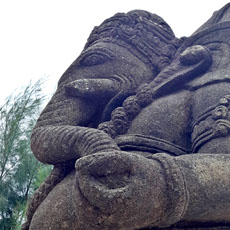
PERMANENT EXHIBITION
Thonburi-Rattanakosin art
The length of Thonburi art was brief (only 15 years) and it was the continuation of the Ayutthaya art. Thonburi Buddha images in Royal Attire have epaulets on the shoulders (similar to King Taksin the Great royal wardrobe) and many Buddha images in this style were discovered in Southern Thailand. There were many changes Buddha images produced during Ratanakosin periods compared to prior artistic styles especially the head and the pedestal that were uniquely created in this period.
ศิลปะธนบุรี-รัตน์โกสินทร์
ศิลปะธนบุรีมีอายุของงานศิลปะเพียง 15 ปี เป็นศิลปะที่มีความต่อเนื่องจากศิลปะสมัยอยุธยา นิยมสร้างพระพุทธรูปแบบทรงเครื่องที่ทรงสวมอาภรณ์ที่มีอินธนูอยู่เหนือพระอังสา (บ่า)คล้ายเครื่องทรงของสมเด็จพระเจ้าตากสินมหาราชและมีการค้นพบจำนวนมากในดินแดนทางตอนใต้ของประเทศไทยศิลปะรัตนโกสินทร์เป็นศิลปะที่มีการเปลี่ยนแปลงจากของเดิมมากพอสมควรโดยเฉพาะส่วนของพุทธลักษณะของส่วน พระเศียรและองค์ฐานและจะมีเอกลักษณะพิเศษ
Sukhothai Art
Sukothai Kingdom was established in 1238. Sukothai art resembled both Chiang Saen and Khmer arts and, later on with the additional influence of Lanka art, Sukothai art evolved and developed its own classic and unique Sukothai art identity. Sukothai art can be classified into 4 major periods with 3 primary schools of craftsmanship that were the Nakorn Luang style, the Kampaengpetch style and the Pitsanulok style .
ศิลปะสุโขทัย
อาณาจักรสุโขทัยถูกก่อตั้งแต่เมื่อประมาณปีคริสต์ศักราช 1238 ศิลปะสุโขทัยมีรูปแบบดั่งเดิม คล้ายศิลปะเชียงแสนผสมกับศิลปะกัมพูชาต่อมาศิลปะสุโขทัยถูกเติมเต็มและพัฒนาลงตัวได้อย่าง งดงามสมบูรณ์ด้วยศิลปะลังกาที่เข้ามามีส่วนร่วมจนเป็นศิลปะที่เป็นเอกลักษณ์โดดเด่นเฉพาะตัว ศิลปะสุโขทัยยังแบ่งออกเป็น 3 สกุลช่างที่โดดเด่นได้แก่ สกุลช่างนครหลวงสกุลช่างกำแพงเพชร และ สกุลช่างพิษณุโลก
Beads and Jade
Beads have been fascinating artifacts and have been evolving with humanities around the world since prehistoric time until the present day. Beads and Jade exhibited here are ceremonial beads from Tibet, trade beads, heirloom jades and ornamental beads.
ลูกปัดและหยก
ลูกปัดเป็นประดิษฐ์กรรมที่มนุษย์สร้างขึ้นตั้งแต่สมัยก่อนประวัติสาสตร์เมื่อหลายหมื่นหลายพันปีมาแล้ว ลูกปัดมีประวัติความเป็นมาในหลายประเทศตั้งแต่สมัยก่อนประวัติศาสตร์มาจนถึงปัจจุบัน ลูกปัดและหยกที่นำมาแสดงมีทั้งลูกปัดที่ใช้ในพิธีกรรมทางศาสนาของทิเบตใช้ในการแลกเปลี่ยนสินค้าแทนเงิน ใช้เป็นสมบัติประจำวงศ์ตระกูล และ ใช้เป็นเครื่องประดับในสมัยโบราณ
Lan Xang (Loa) art
King Fa Ngum of Lan Xang kingdom officially adopted Buddhism in 1358 from Kampuchean kingdom. The first Buddha image of Lan Xang kingdom is Phra Bang(a post-Bayon style royal Buddha image in the Dispelling Fear mudra, a standing Buddha with palms facing forward). Even though, Lan Xang Buddha images in later period had been influenced by near-by territories, Lan Xang artists managed to create their own artistic identities that can be seen clearly in the varieties and unique facial shape and pedestal designs of Buddha images.
ศิลปะพระพุทธรูปล้านช้าง (ลาว)
อาณาจักรล้านช้างรับเอาพระพุทธศาสนาเข้าสู่พระราชอาณาจักรอย่างเป็นทางการในสมัยเจ้าฟ้างุ้มมหาราช เมื่อปี ค.ศ. 1358 จากอาณาจักรกัมพูชา พระพุทธรูปองค์แรกของอาณาจักรล้าน ช้างคือ พระบาง เป็นพระพุทธรูปศิลปะสมัยหลังบายน ทรงประทับยืนพระพุทธรูปในระยะ ต่อๆมาได้รับอิทธิพลจากศิลปะของอาณาจักรข้างเคียงแต่ศิลปะล้านช้างก็มีความเป็นอิสระสามารถสร้างเอกลักษณ์ของตนเองได้เด่นชัดโดยเฉพาะรูปพระพักตร์และองค์ฐานที่ไม่ซ้ำแบบเดิมและไม่เหมือนศิลปะสกุลใด
Pre-historic art and Ban Chiang art
Generally speaking, Ban Chiang is a representative name of pre-historic arts found in Thailand and near-by territories. The most famous artifacts found in Ban Chiang were baked clay pottery jar with red patterns resembling river stream flow. Ban Chiang art was popularized globally in 1967. In 1966, University of Pennsylvania dated Ban Chiang artifacts and concluded that Ban Chiang civilization existed about 5,600 years ago.
ศิลปะก่อนประวิตศาสตร์ และ ศิลปะบ้านเชียง
ศิลปะบ้านเชียงเป็นสรรพนามหรือตัวแทนของงานศิลปะยุคสมัยก่อนประวัติศาสตร์ที่มีการค้นพบกระจัดกระจายอยู่ในประเทศไทยและประเทศใกล้เคียงภาชนะดินที่สร้างชื่อเสียงให้กับบ้านเชียงคือ ภาชนะดินเผาลายเขียนสีแดงฝาดคล้ายลายกระแสน้ำศิลปะบ้านเชียงเป็นที่รู้จักแพร่หลายไปทั่วโลกเมื่อปี ค.ศ. 1966 เมื่อมหาวิทยาลัยเพนซิลเวเนียตรวจสอบอายุของวัตถุโบราณเหล่านี้แล้ว สรุปได้ว่ามีอายุถึง 5,600 ปี จึงทำให้มีการศึกษาค้นคว้าและทำงานวิจัยออกไปอย่างกว้างขวาง
Srivijaya Art and Southern Style Thai Buddha Images
Srivijaya Art is a fusion art from many artistic schools because Srivijaya Kingdom adopted many artistic schools from many cultures and traditions due to the kingdom's location as the port and commerce center of Indochinese Peninsula in the ancient time. Srivijaya Art was influenced by north-Indian and Funan Kingdom and, later, by Sri Lanka and south-Indian styles such as Pallava and Jola styles. In later period, Srivijaya art was influenced greatly by Cambodian Empire (Ankor period) and, in lesser extent, Cham style. Srivijaya Kingdom was assimilated into Ayutthaya Kingdom in the mid-14th century.
ศิลปะศรีวิชัยและศิลปะพระพุทธรูปทางใต้ของไทย
ศิลปะศรีวิชัย เป็นศิลปะลูกผสมที่เกิดจากการผสมผสานของศิลปะหลายสกุลช่างเหตุเพราะอาณาจักรศรีวิชัย ตั้งอยู่ในบริเวณคาบสมุทรอันเป็นทำเลของที่ตั้งเมืองท่าและศูนย์กลางทางการค้าในอดีตทำให้อาณาจักรศรีวิชัยได้รับเอาศิลปะและวัฒนธรรมต่างๆเหล่านี้เข้าสู่อาณาจักรของตนเช่นรูปแบบมาจากอินเดียเหนือและอาณาจักรฟูนัน ต่อมาได้รับศิลปะจากศรีลังกาและอินเดียใต้ เช่น อาณาจักรปัลลวะ และโจฬะส่วนในช่วงปลายศิลปะ ศรีวิชัยได้รับอิทธิพลทางศิลปะจาก อาณาจักรกัมพูชาสมัยเมืองพระนครหลวงรวมทั้งศิลปะจามที่เข้ามาร่วม ศิลปะเล็กน้อยอาณาจักรศรีวิชัยถูกผนวกเข้าสู่รัฐไทยอยุธยาอย่างเป็นทางการเมื่อประมาณกลางคริสต์ศตวรรษที่ 14
Christian arts
Jesus and saint sculptures in this gallery were made around 17th century. The bodies are made of hardwood and the apparels, in some, are made of sheep leather. The faces are enameled with special pigments or made of ceramic. For small figurines, the faces may be covered with ivory or bones. These sculptures were made in Portuguese and France and, later, were restored in Vietnam.
ศิลปะศาสนาคริสต์
พระเยซูกับนักบุญองค์ต่างๆในห้องจัดแสดงนี้ถูกสร้างในคริสต์ศตวรรษที่ 17 โดยพระวรกาย ทำจากไม้ พระอาภรณ์แกะจากไม้หรือ (ในบางองค์) ทำจากหนังแกะพระพักตร์ส่วนใหญ่จะ ใช้สีเคลือบพิเศษหรือทำจากเซรามิกหากเป็นองค์ไม่ใหญ่พระพักตร์จะบุงาช้างหรือกระดูกสัตว์ เป็นงานศิลปะของชาวโปรตุเกสและฝรั่งเศสในระยะหลังปฏิมากรรมที่ได้รับการซ่อมแซมในเวียตนาม
The Yao ceremonial paintings
Painting is the most famous art form of the Yao people. What unique about The Yao people was that they believed in pure Chinese Taoist Tantra doctrine (without any trace of Tantra Buddhism). Most of the Yao artifacts found today are the ceremonial paintings that can be traced back to the Han dynasty. Even though, worshiping sacred idols had been more popular among the Yao, only portable artifacts have been kept and survived until today because of their wandering agricultural culture and Chinese government harassment. The Yao believes that the more frequent the paining takes part in ceremonial rituals the more sacred it becomes.
ภาพพิธีกรรมของชนเผ่าเย้า
ศิลปะเย้าที่มีชื่อเสียงมากที่สุดคือภาพจิตรกรรมที่ใช้งานเขียนสีภาพวัสดุธรรมชาติสิ่งที่น่าแปลกคือ เป็นชนเผ่าที่นับถือศาสนาเต๋าตันตระ โดยไม่มีพุทธตันตระเจือปนศิลปะด้านจิตรกรรมอัน ศักดิ์สิทธิ์สำหรับทำพิธีกรรมของเย้าได้รับมาตั้งแต่ราชวงศ์ฮั๋นชนเผ่าเย้าแต่เดิมก็นิยมสร้างรูป เคารพแต่เนื่องจากต้องเร่ร่อนทั้งยังถูกรัฐบาลจีรบกวนในช่วงหลังจึงทำให้ศิลปะโบราณวัตถุของเย้าจะปรากฏหลงเหลือให้เห็นเฉพาะภาพจิตกรรมที่สามารถม้วนเก็บและเคลื่อนย้ายได้ง่ายคล้ายกับ ภาพพระมงกุฎของชาวทิเบตเพราะเหตุนี้ภาพจิตรกรรมศักดิ์สิทธิ์ที่สวยงามของเย้าที่ผ่านการทำพิธีมามากจึงมีคุณค่ายิ่ง
Myanmar art
Myanmar art can be classified into 2 important periods that were Pre-historical period or pre-Pagan (c. 250 BC to 1040 AD) and Post-Pagan period or Post-Pagan to Mandalay period (c. 1040 – 1885). The Post-Pagan period, there were 4 schools of craftsmanship: Myanmar, Mon, Arakanese and Shan (or Tai Yai).
ศิลปะเมียนมาร์
ศิลปะเมียนมาร์ สามารถแบ่งออกเป็นสองช่วงใหญ่สำคัญคือ สมัยก่อนประวัติศาสตร์หรือช่วง สมัยก่อนอาณาจักรพุกาม (อยู่ระหว่างช่วงประมาณ 250 ปี ก่อนคริสตกาลจนถึงปีคริสต์ศักราช 1040) และสมัยประวัติศาสตร์หรือสมัยหลังจากสถาปนาอาณาจักรพุกามจนถึงสมัยมัณฑะเลย์ (อยู่ระหว่างปีคริสต์ศักราชที่ 1040-1885) ศิลปะสมัยประวัติศาสตร์จะมีทั้งหมด 4 สกุลช่างสำคัญคือ สกุลช่างเมียนมา สกุลช่างมอญ สกุลช่างอาราข่าน และสกุลช่างไท-ใหญ่
Avalokiteśvara or Guānshìyīn Púsà
Goddess Guanyin or Guānshìyīn Púsà is a commonly known name of Avalokiteśvara among Thais and Chinese descendants. From studying the evolutional path of Mahāyāna doctrine from Chinese tradition, the doctrine refers to this bodhisattva in two forms, male and female. The male form is earlier known form and usually called Avalokiteśvara and the female form is usually called Guānshìyīn Púsà and both forms are a bodhisattva who represents the universal manifestation of compassion, who hears the cries of sentient beings, and who works tirelessly to help those who call upon his/her name.
พระโพธิสัตต์อวโลกิเตศวรหรือกวนซิอิมผ่อสัก
เจ้าแม่กวนอิมกับองค์พระโพธิสัตต์อวโลกิเตศวรเป็นพระโพธิสัตต์องค์เดียวกันแต่จากการศึกษาและการพัฒนาของพระสูตรของฝ่ายศาสนาพุทธนิกายมหายานของจีนทำให้พระโพธิสัตต์พระองค์นี้มี 2 ภาคคือ ภาคแรกเป็นพระโพธิสัตต์ที่อยู่ในสถาวะของบุรุษเพศส่วนภาคที่สองทรงอยู่ในสภาวะของ สตรีเพศแต่ทั้งสองภาคก็ทรงเป็นพระโพธิสัตต์ที่เปลี่ยมล้นด้วยความเมตตามหากรุณายิ่งต่อการช่วยเหลือเหล่าสรรพสัตว์ให้พ้นทุกข์
Hermit
Hermit has existed for more than 4,000 years. Hermit, in generic sense, is an individual who is living an ascetic form of life regardless of religious and believes. The prophets of most religions were once students of hermits because the hermits lived the ascetic eremitic life and seek solitude for meditation, contemplation, and renounced the worldly concerns and pleasures. Consequently, the hermits attained deep inner peace and wisdom and were very compassionate and could perform miracles. Therefore, hermits are venerable and that anyone who earnestly, correctly and faithfully worship a right hermit should receive protection and prosper in life.
พระฤาษี
พระฤาษีที่มีมานานแล้วกว่า 4,000 ปี พระฤาษีคือผู้ทรงศีลอิสระไม่จำเป็นต้องสังกัดศาสนาหรือ ศาสดาองค์ใดก็ได้ พระศาสดาเกือบทุกศาสนาต่างเคยเป็นลูกศิษย์ของพระฤาษีหรือนักบวชอิสระ ทั้งสิ้นเพราะพระฤาษีเป็นผู้ทรงศีลที่มีปณิธานแน่วแน่และเคร่งครัดต่อการบำเพ็ญเพียรจนแกร่งกล้าสามารถบรรลุธรรมระดับสูงได้ทำให้พระฤาษีมีเมตตาธรรมและมีฤทธาอภินิหารสูงมาที่เกิดจากผลของการบำเพ็ญตบะของตน พระฤาษีจึงเป็นนักบวชอิสระที่ผู้คนทั่วไปเคารพนับถือและบูชาเหตุ เพราะเชื่อว่าหากผู้ใดบูชาองค์พระฤาษีได้ถูกต้องจริงจังที่เต็มเปี่ยมด้วยความศรัทธาบุคคลนั้นจะได้รับการคุ้มครองและประสบกับการดำรงชีวิตที่เจริญรุ่งเรืองปราศจากอุปสรรคใดๆ
Dong Son Culture and Vietnamese Culture
The Kingdom of Vietnam was under Chinese Empire as a county in China. The oldest artifacts discovered in Vietnam were from Dong Son Culture and followed by Annam art. After the founding of the Kingdom of Vietnam, artistic styles in this period could be classified in to 2 periods: Dai Viet period (c. 10th – 19th centuries) and Vietnam art after the founding of the Kingdom of Vietnam (19th – 20th centuries) by Emperor Gia Long.
วัฒนธรรมดองซอง-เวียดนาม
อาณาจักรเวียดนามแต่เดิมอยู่ภายใต้การปกครองของจักรวรรดิจีนศิลปะเก่าแก่มากที่สุดที่ได้มีการค้นพบในเวียดนามคือ ศิลปะแบบวัฒนธรรม ดองซอง และต่อด้วยศิลปะ อันนัมหลังจากได้มีการ สถาปนาอาณาจักรที่สามารถแบ่งออกเป็นสองช่วงคือ ช่วงแรกศิลปะสมัย ไดเวียดตั้งแต่ต้นคริสต์ ศตวรรษที่ 10-19 และ สมัย เวียดนาม ที่อยู่ระหว่างปีคริสต์ศตวรรษที่ 19-20 โดยเริ่ม ตั้งแต่จักรพรรดิเกียลอง
Dvaravati art
Dvaravati art is the origin of Thai history as Mon-Dvaravati ethnic group had settled in the present-day Thailand region for 2,500-4,000 years. Art historian dated Dvaravati art to be between c. 6th- c. 11th centuries and post-Dvaravati to be between c. 11th- c. 12th centuries. Dvaravati Buddha image was influenced by India art and Lanka art as seen in its half-lotus sitting position. Dvaravati art has influenced Lopburi, U-Thong and every periods of Thai arts until the present day.
ศิลปะทวาราวดี
ศิลปะทวาราวดีคือศิลปะต้นประวัติศาสตร์ไทยเพราะชนชาติมอญทวารวดีตั้งถิ่นฐานอยู่ในดินแดนประเทศไทยปัจจุบันมานานแล้วประมาณ 2,500 – 4,000 ปี อายุของศิลปะทวาราวดีถูก นักประวัติศาสตร์ศิลปะจัดให้อยู่ระหว่างปีคริสต์ศตวรรษที่ 6-11 และ 11-12 (ศิลปะสมัย หลังทวาราวดี) พระพุทธรูปศิลปะทวาราวดีได้รับอิทธิพลจากศิลปะอินเดียและลังกา (นั่งขัด สมาธิราบ) และศิลปะแบบทวาราวดีได้ส่งอิทธิพลให้กับศิลปะลพบุรี ศิลปะอู่ทองและศิลปะ ทุกยุคสมัยของไทยตามลำดับจนถึงปัจจุบัน
Pre-Lan Na art and Lan Na art
Northern Thai artistic styles before the establishment of Lan Na Kingdom is Chiang Saen art (c.11th – c.13th centuries). After the establishment of Lan Na Kingdome with Si Nakhon Phing Chiangmai as its capital city, Pure Lan Na art was created by the many artistic school which were: Chaing Mai, Lan Na-Haripunchai, Fang, Chaiprakarn, Nan, Kelangnakorn (Lampang), Payao and Tai Lu
ศิลปะสมัยก่อนล้านนา และศิลปะสมัยล้านนา
ศิลปะทางภาคเหนือของไทยก่อนที่จะมีการสถาปนาอาณาจักรล้านนาคือ ศิลปะเชียงแสนที่อยู่ใน ช่วงระหว่างปีคริสต์ศตวรรษที่ 11-13 แต่หลังจากมีการสถาปนาอาณาจักรล้านนาและมีการสร้าง เมืองราชธานี ศรีนครพิงค์เชียงใหม่ แล้วศิลปะล้านนาบริสุทธิ์ได้ประกอบด้วยสกุลช่างต่างๆ ที่เกิด จากการรวมตัวของ โดยศิลปะที่เป็นสกุลช่างโดดเด่นสามารถแยกแยะออกได้อย่างชัดเจนดังนี้คือ ศิลปะเชียงใหม่ ศิลปะหริภุญชัย (ลำพูน) ศิลปะฝาง ศิลปะไชยปราการ ศิลปะน่าน ศิลปะเขลางค์นคร (ลำปาง) ศิลปะพะเยา และ ศิลปะไทยลื้อ
Lopburi and Kampuchean art
Lopburi art was onced considered Kampuchean art; but, with careful studies and researches, , it is clear that Lopburi art was clearly different from Kampuchean arts in many aspects. Kampuchean art was influenced by Indian art and Lanka art (sitting posture in half-lotus position) but, after Ankor period, Cambodian Kingdom adopted Theravada Buddhism (Lanka sect). Consequently these changes caused Buddha images in this period to have mixed artistic styles between Khmer arts and Siamese arts (from Ayutthaya to Ratanakosin period). Loburi art was named after its first official discovery site in Lopburi province in Thailand. Pure Lopburi art was a fusion artistic style created after the collapse of Confederate City States of Thavaravadi in mid 11th century) that allowed harmonious cultural fusion between Mon-Thavaravadi and High-land Kampuchean. Later, Lopburi art went through another transformation that resulted in simpler and cleaner artistic style due to the adoption of Theravada Buddhism.
ศิลปะลพบุรีและศิลปะกัมพูชา
ศิลปะลพบุรีเคยถูกคิดว่าเป็นศิลปะกัมพูชาแต่จากการศึกษาและวิจัยอย่างระมัดระวังทำให้ค้นพบว่า ศิลปะลพบุรีนั้นแตกต่างจากศิลปะกัมพูชาอย่างมากศิลปะกัมพูชาได้รับอิทธิพลจากศิลปะอินเดียและลังกา (จากลักษณะการนั่งขัดสมาธิราบ) และต่อมาในสมัยนครหลวงอาณาจักรกัมพูชาได้รับ พุทธศาสนานิการเถรวาทจากลังกาซึ่งทำให้เกิดการเปลี่ยนแปลงในการสร้างพระพุทธรูปเป็นแบบลูกผสมกัมพูชาและสยามส่วนศิลปะลพบุรีนั้นถูกตั้งชื่อที่สถานที่ค้นพบแห่งแรกคือจังหวัดลพบุรีในประเทศไทย ซึ่งศิลปะลพบุรีบริสุทธิ์นั้นเกิดจากการล่มสลายของสหนครรัฐทวาราวดีในศตวรรษที่ 11 ซึ่งได้รับการผสมผสานจากศิลปะชาวมอญ-ทวาราวดี และ ศิลปะจากชาวเขมรสูงต่อมาศิลปะลพบุรี ได้เกิดการเปลียนแปลงอีกครั้งเนื่องจากได้รับเอาพุทธศาสนานิกายเถรวาทซึ่งทำให้ศิลปะมีรูปแบบที่เรียบง่ายและดูสะอาดตามากขึ้น
Ayutthaya art
Ayutthaya art was a Thai art and it had lasted for 471 years (from 1350 to 1767). Early Ayutthaya art inherited many traits from U-Thong art. When Ayutthaya Kingdom conquered Sukhothai Kingdom and Sukhothai art was assimilated with Ayutthaya art. Around 17th century during the reign of King Prasat Thong, Buddha image in Royal Attire with very high pedestal was invented.
ศิลปะอยุธยา
ศิลปะอยุธยาเป็นศิลปะของชนชาติไทยที่มีอายุยาวนานถึง 417 ปี คือตั้งแต่ปี ค.ศ. 1350 – 1767 ศิลปะอยุธยาตอนต้นจะรับรูปแบบศิลปะต่อเนื่องมาจากศิลปะอู่ทองเมื่อประมาณกลาง คริสต์ศตวรรษที่ 15 ได้นำเอาศิลปะสุโขทัยเข้ามาร่วมศิลปะด้วย จนถึงต้นคริสต์ศตวรรษที่ 17 ในรัชสมัยของพระเจ้าปราสาททองทรงให้มีการสร้างพระพุทธรูปแบบทรงเครื่องใหญ่เป็นครั้งแรก
GUAN YIN SHRINE
Entering the Guanyin shrine, you will be greeted by a golden Guanyin statue, the principal deity of the shrine. The statue is in pouring immortal elixir post with Nezha statue receiving the holy elixir at her feet. There are five altars featuring statues of Chinese gods with an ancient Guanyin as the principal in the middle flanked by Xuán tiān shàngdì, Tiān-shàng-shèng-mǔ, Chao Mae Lim Ko Niao and Guan Yu. Adjacent to the shrine, there is an antique jar garden housing a Brahma shrine with a 200-year Brahma statue. All sacred icons in this shrine are a part of the museum collections.
ศาลเจ้าแม่กวนอิม
เมื่อเดินออกจากตัวพิพิธภัณฑ์ท่านจะได้รับการต้อนรับจากปฏิมากรรมเจ้าแม่กวนอิมในปางเทน้ำอมฤติโดยมีเทพนาจารอรับอยู่ข้างล่างนอกจากนี้ยังมีศาลเจ้าอีกห้าศาลโดยมีเจ้าแม่กวนอิมโบราณจากเวียดนาม อายุกว่า 200 ปี เป็นประธานอยู่ตรงกลางและขนาบด้วยศาลเจ้าพ่อตั่วเหล่าเอี้ย,ศาลเจ้าแม่ทับทิม, ศาลเจ้าแม่ลิ้มกอเหนี่ยวและศาลเจ้าพ่อกวนอู นอกจากนี้ยังมีสวนโอ่งโบราณซึ่งเป็นที่ประทับของท้าวมหาพรหมซึ่งรูปปฏิมากรรมท้าวมหาพรหมนี้อายุประมาณ 200 ปีซึ่งสร้างในสมัยรัชกาลที่ 1 รูปปฏิมากรรมทั้งหมดนั้นเป็นส่วนหนึ่งของงานแสดงซึ่งทางพิพิธภัณฑ์นำออกมาให้ผู้เข้าชมได้สักการะ
Ganesha Temple
Ganesha shrine locates in a separate area from the Museum of Buddhist Art building. The design of this shrine represents Lingam, a sacred symbol of Hinduism. On the roof, there is a golden Shiva Linga presides on top of Yoni. A Ganesha statue the principal deity abodes in the middle chamber flanked by a chamber of Shiva and his consort Parvati on one side and a chamber of Trimurti statue, the combination form of Shiva, Vishnu and Brahma. Outside the building, there is a thousand years old Ganesha carved from stone and a Brahma shrine.
เทวาลัยพิฆเนศวร
เทวาลัยพิฆเนศวรนี้อยู่ในพื้นที่ที่แยกออกจากตัวอาคารพิพิธภัณฑ์พุทธศิลปะหนองปรือการออกแบบของตัวอาคารเทวาลัยพิฆเนศวรนี้ ออกแบบในรูปแบบสมัยใหม่เชิงสัญลักษณ์โดยสัญลักษณ์ของศิวลึงค์สีทองอยู๋บนหลังคาของตัวอาคารที่เป็นสัญลักษณ์ของโยนีของพระแม่อุมาเทวี ภายในมีองค์พระพิฆเนศวรขนาดใหญ่เป็นองค์ประธาน และ มีองค์พระศิวะ พระแม่อุมา และองค์ตรีมูรติขนาบซ้ายขวา ด้านนอกในสวน มีองค์พระพิฆเนศวรศิลาอายุกว่าหนึ่งพันปี และศาลท้าวมหาพรหม เทวาลัยแห่งนี้เป็นส่วนหนึ่งของพิพิธภัณฑ์และเปิดให้เข้าชมฟรีทุกวัน
RATTANAKOSIN
SUKHOTHAI
BEADS AND JADE
LAN XANG
Ban Chiang
Srivichai
Christian
Yao Paintings
Myanmar
and Tai Lue
GUAN YIN AND
CHINESE GODS
Hermit
Dong Son
& Vietnam
Davaravadi
Lanna
Lopburi
AYUTTHAYA
GUAN YIN SHRINE
GANESHA TEMPLE
© 2015 The Foundation of Promotion and Preservation of Thai Arts
